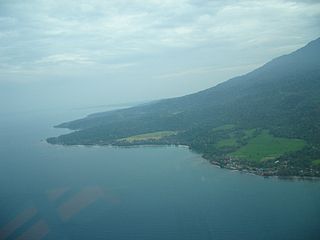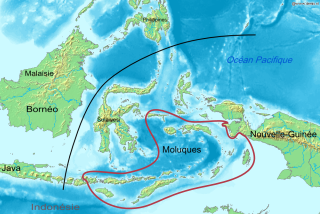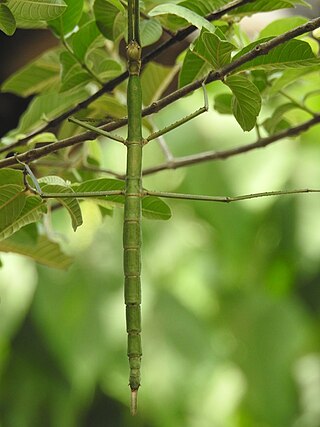
Halmahera, formerly known as Jilolo, Gilolo, or Jailolo, is the largest island in the Maluku Islands. It is part of the North Maluku province of Indonesia, and Sofifi, the capital of the province, is located on the west coast of the island.

UTC+09:00 is an identifier for a time offset from UTC of +09:00.
The Sula Islands Regency is one of the regencies in North Maluku province of Indonesia. It was originally formed on 25 February 2003, when it encompassed the three large islands comprising the Sula Archipelago, together with minor adjacent islands. However, the largest and most westerly of the three, Taliabu, was split off from the Sula Islands Regency on 14 December 2012 to form a separate regency.

The Seram Sea or Ceram Sea is one of several small seas between the scattered islands of Indonesia. It is a section of the Pacific Ocean with an area of approximately one hundred twenty thousand square kilometres (46,000 sq mi) located between Buru and Seram, which are two of the islands once called the South Moluccas. These islands are the native habitat of plants long coveted for their use as spices, such as nutmeg, cloves, and black peppercorns, and the seas surrounding them were busy shipping routes. The Seram Sea is also the habitat of several species of tropical goby and many other fish. Like many other small Indonesian seas, the Seram Sea is rocky and very tectonically active.

The Central Malayo-Polynesian languages (CMP) are a proposed branch in the Malayo-Polynesian subgroup of the Austronesian language family. The languages are spoken in the Lesser Sunda and Maluku Islands of the Banda Sea, in an area corresponding closely to the Indonesian provinces of East Nusa Tenggara and Maluku and the nation of East Timor, but with the Bima language extending to the eastern half of Sumbawa Island in the province of West Nusa Tenggara and the Sula languages of the Sula archipelago in the southwest corner of the province of North Maluku. The principal islands in this region are Sumbawa, Sumba, Flores, Timor, Buru, and Seram. The numerically most important languages are Bima, Manggarai of western Flores, Uab Meto of West Timor, and Tetum, the national language of East Timor.

Taliabu Island Regency is a regency in the North Maluku province of Indonesia, mainly consisting of the island of Taliabu, the most western geographically of the Sula Islands archipelago. It was formerly part of the Sula Islands Regency, but on 14 December 2012 it was administratively separated to form a separate regency. It is located to the west of Mangole Island and Sanana Island, the two islands which remain part of the Sula Islands Regency. Taliabu Island Regency covers 2,985.75 km2; it had a population of 47,309 at the 2010 Census and 58,047 at the 2020 Census; the official estimate as at mid 2022 was 63,231.

Mangoli or Mangole is a large island in the Sula Islands, which are part of North Maluku province in Indonesia. It is located at 1.8°S 125.8°E, east of Taliabu Island and north of Sanana Island. It has an area of 2,142.48 km2. At the 2010 Census, 36,323 people lived on the island of Mangoli, which rose to 39,736 at the 2020 Census. Its economy is dominated by the timber industry.

Sanana or Sulabesi Island is an island south of Mangoli Island, and is part of the Sula Islands Regency in the North Maluku province of Indonesia. Sanana is also the name of that island's largest settlement, home to the Dutch era fort Benteng De Verwachting.
The Sula rat is a species of rodent in the family Muridae. It is found only in Indonesia, on Taliabu and Mangole islands in the Sula Archipelago. On Sanana island, only the introduced Rattus tanezumi and Rattus exulans are found.

The great-billed kingfisher or black-billed kingfisher is a species of bird in the subfamily Halcyoninae. It is endemic to the Sulawesi region of Indonesia. It can be found on the island of Sulawesi and in the Sula Archipelago.
The sago monitor or torch monitor is a species of monitor lizards endemic to the Indonesian island of Sanana.
Lisela, also called Li Enyorot, is an Austronesian language; in 1989 it was spoken by about 11,900 Lisela people mostly living in the northern part of Indonesian island Buru. It is also preserved among the small Lisela community on the Ambon Island.
The 1965 Ceram Sea earthquake occurred on January 24 at 00:11 UTC with a moment magnitude of 8.2 and its epicenter was located just off the southwestern coast of Sanana Island in eastern Indonesia. The event occurred at a depth of 28 kilometers under the Ceram Sea, and a tsunami was generated which caused damage in Sanana, Buru, and Mangole. During the tsunami three consecutive run-ups were reported in Seram Island, and a four-meter run-up was reported at Buru Island.

The Halmahera naked-backed fruit bat is a common and widespread species of megabat in the family Pteropodidae. It is endemic to Indonesia. The bat's non-Moluccan populations are apparently an undescribed separate sub-species.

Lexias aeropa, the orange-banded plane, is a butterfly in the family Nymphalidae. It is found in South-East Asia and Australia.
Mangole is a dialect of the Sula language that is primarily spoken on Mangole Island in Indonesia.
Emalamo Airport is an airport in Sanana, Sula Islands Regency, North Maluku. It has a runway measuring 1,100 x 23 m.

Nesiophasma is a genus of very large stick insects within the order Phasmatodea and the tribe of Stephanacridini. This genus is found in Wallacea west of Weber’s Line: Sulawesi, Peleng Island, Selayar Island, Kalaotoa Island, Sanana Island, Romang Island, Timor Island, Sangihe Island and Talaud Islands. New Guinea with doubt. The largest in the list of species is Nesiophasma giganteum, with females reaching a body length of 30 cm.













